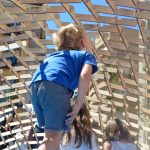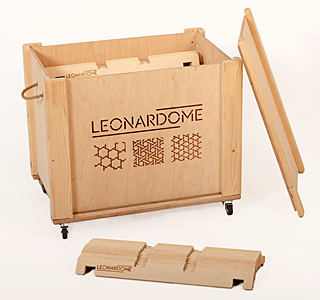The exhibition of sculptures “Mathematical Art” by Rinus Roelofs can be seen at Cosmocaixa since 9 February. We interviewed this artist and mathematician who inspired Leonardome.
How important is Leonardo da Vinci in your experiments with geometric figures and mathematics?
At one point, while experimenting with building structures, I found a fantastic way to build domes. And when I started building those domes, it seemed inconceivable to me that I would be the first to discover the mathematical principles that underpinned them. So I began a long process of searching until, finally, I found Leonardo da Vinci’s drawings in his Codex Atlanticus that seemed to contain the same idea of building domes. That was the connection with Leonardo, and it was wonderful.
What did the discovery of Codex Atlanticus imply for your research and work?
Finding that connection to Leonardo was something special. Even today there is no clear explanation of what these Codex Atlanticus drawings mean. But I felt I could recognize those patterns because my previous drawings of three-dimensional domes were exactly the same as Leonardo’s ones. It was fantastic to be able to understand part of those drawings.
They’ve compared your works to M.C. Escher’s fascinating and almost impossible drawings… What do they have in common?
I don’t know if we have much in common. Escher has obviously inspired me, especially because there aren’t many artists in the field of mathematical art or the art of mathematics. And I think Escher was one of the first in this or at least one of the most famous. But my work is very different from his: he only worked with the two dimensions, and I am more interested in the three dimensions. We both share an interest in making mathematics visible.
The Leonardome domes begin with the search for patterns. What do you think of the final result?
I am very happy with the connection with Leonardome and the Museum of Mathematics of Catalonia (MMACA). I’ve really enjoyed working with the domes, and that’s why I want more people to have as much fun as I do. What you do with Leonardome is share this fun, making these materials available to everyone. And that’s a fantastic thing.
Do the domes of Leonardome have an architectural value?
I think they can be used in the field of architecture, and also in other fields. But that’s not what interests me. I am not an architect, I am a sculptor, and I dedicate myself to creating “useless” things. For me there are always new patterns, new ways of building structures, of creating mathematical sculptures. But I’m sure others could explore these possible uses of domes.
How can Leonardome help at the educational level?
The kids play with the domes, and they have a good time. They handle them without problem, and the size is right for them. Look at their faces when they’re building with Leonardome: I think what’s going on is just great.






